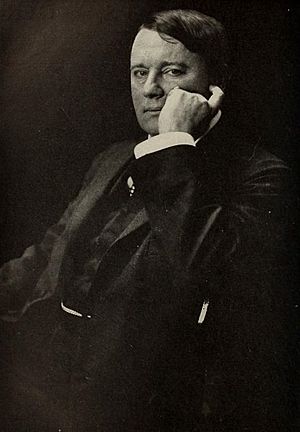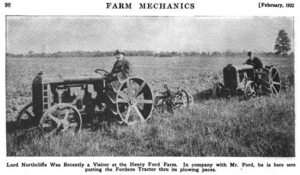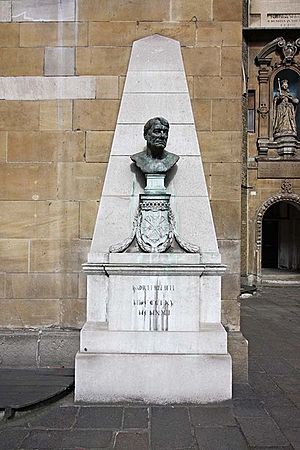Alfred Harmsworth, 1st Viscount Northcliffe facts for kids
Quick facts for kids
The Viscount Northcliffe
|
|
|---|---|

Photograph by Gertrude Käsebier (1908)
|
|
| Born |
Alfred Charles William Harmsworth
15 July 1865 Chapelizod, County Dublin, Ireland
|
| Died | 14 August 1922 (aged 57) Carlton House Gardens, London, England
|
| Nationality | British |
| Education | Stamford School |
| Occupation | Publisher |
| Title | 1st Viscount Northcliffe |
| Spouse(s) |
Mary Elizabeth Milner
(m. 1888) |
| Children | (had children) |
| Parent(s) | Alfred Harmsworth Geraldine Mary Maffett |
| Relatives | Cecil Harmsworth (brother) Harold Harmsworth (brother) Leicester Harmsworth (brother) Hildebrand Harmsworth (brother) St John Harmsworth (brother) |
Alfred Charles William Harmsworth (born July 15, 1865 – died August 14, 1922) was a very important British newspaper owner. He was known as the 1st Viscount Northcliffe. He owned famous newspapers like the Daily Mail and the Daily Mirror.
He helped create popular journalism, which meant making newspapers that many people wanted to read. He had a huge impact on what British people thought, especially during the Edwardian era. A famous person named Lord Beaverbrook once said he was "the greatest figure who ever strode down Fleet Street", which is a famous street in London known for newspapers.
Around the early 1900s, more people tried to make newspapers for everyone, including working-class people. These papers often focused on exciting stories. Harmsworth was a leader in this new way of journalism.
Northcliffe also played a big part during the First World War. He spoke out against the government about problems like the Shell Crisis of 1915. In 1917, he led a special trip to the United States, which was a new ally. In 1918, he was in charge of spreading information against the enemy.
His company, Amalgamated Press, hired famous writers. It also published educational books like The Harmsworth Self-Educator and The Children's Encyclopædia. In the 1890s, his cheap half-penny magazines, like Illustrated Chips, became very popular. They were almost the only comics in the UK until the 1930s.
Contents
About Alfred Harmsworth's Life
Early Life and Publishing Success
Alfred Harmsworth was born in Chapelizod, County Dublin, Ireland. His parents were Alfred and Geraldine Harmsworth. He went to school in Lincolnshire, England, and later in Kilburn, London. A teacher at his school, J. V. Milne, helped him start a school magazine. This was important for his future.
Harmsworth started as a freelance journalist. He launched his first newspaper, Answers. His brother Harold, who was good at business, later helped him. Harmsworth had a special talent for knowing what readers wanted. He started many cheap but successful magazines, like Comic Cuts and Forget-Me-Not for women.
From these magazines, he built the biggest magazine publishing company in the world, called Amalgamated Press. His half-penny magazines in the 1890s helped to make the old "penny dreadfuls" less popular.
Building a Newspaper Empire
Harmsworth was a pioneer in popular journalism. He bought several newspapers that were not doing well. He turned them into very successful and profitable news groups. He did this by making them appeal to ordinary people.
He started with The Evening News in 1894. Then he combined two newspapers in Edinburgh to create the Edinburgh Daily Record. In the same year, he helped fund an expedition to the Arctic. The goal was to try and reach the North Pole.
On May 4, 1896, he began publishing the Daily Mail in London. It was a huge hit. It held the world record for daily newspaper sales until he died. The Daily Mail was known as "the busy man's daily journal" and "the penny newspaper for one halfpenny".
Harmsworth also changed a Sunday newspaper, the Weekly Dispatch, into the Sunday Dispatch. This became the Sunday newspaper with the most readers in Britain. He also started the Harmsworth Magazine. He brought his younger brothers into his media business. They all became very successful.
He also started The Daily Mirror in 1903. He saved The Observer in 1905 and The Times in 1908 from financial trouble. In 1908, he also bought The Sunday Times.
Becoming a Nobleman
In 1904, Alfred Harmsworth was given the title of Baronet. This was a special honor. In 1905, he was made a Baron, becoming Baron Northcliffe. This title was requested by King Edward VII.
Later, in 1918, Harmsworth was given an even higher title. He became Viscount Northcliffe. This was for his important work as the director of the British war mission in the United States during World War I.
Family Life
Alfred Harmsworth married Mary Elizabeth Milner on April 11, 1888. They did not have any children together. He did have children from other relationships.
Northcliffe's Political Influence
By 1914, Northcliffe controlled a large part of the newspaper market in Britain. He owned 40% of morning newspapers, 45% of evening papers, and 15% of Sunday papers.
Because he owned The Times, the Daily Mail, and other papers, his opinions reached many people. In a time before radio or TV, Northcliffe had a huge influence on the British press. No one else has had such control since.
Before the First World War, Northcliffe's Daily Mail showed strong anti-German feelings. Some people even said he helped cause the war. His newspapers, especially The Times, reported on the Shell Crisis of 1915 with great energy. This helped lead to the end of the government led by Prime Minister H. H. Asquith. It forced Asquith to form a new government.
Northcliffe's newspapers also pushed for a new government role, the Minister of Munitions. This role was first held by David Lloyd George. This helped Lloyd George become prime minister in 1916. Lloyd George offered Northcliffe a job in his government, but Northcliffe said no. Instead, he became the director for propaganda.
Northcliffe's influence on anti-German information during World War I was so strong that a German warship even tried to attack his house. This was an attempt to get rid of him. His old house still has a shell hole. This is to remember his gardener's wife, who was killed in the attack.
Northcliffe's enemies said he had power without being responsible. But his newspapers helped settle the Anglo-Irish Treaty in 1921. His trip to the United States in 1917 is also seen as a success by historians.
Northcliffe's personality shaped his career. He was very energetic and ambitious. He loved power and money. He had a youthful excitement for everything he did.
Sports and Cars
Motorboat Racing
In 1903, Harmsworth started the Harmsworth Cup. This was the first international award for motorboat racing.
Love for Cars
Harmsworth was friends with Claude Johnson, who was in charge of Rolls-Royce Limited. In the years before World War I, Harmsworth became a big fan of the Rolls-Royce Silver Ghost car.
Death and Legacy


Lord Northcliffe's health got worse in 1921 due to an infection. He became very ill. He went on a trip around the world to try and get better, but it did not help. He died from a heart infection in his London home on August 14, 1922. He left three months' pay to each of his six thousand employees.
A monument to Northcliffe was put up in 1930 at St Dunstan-in-the-West, a church on Fleet Street in London. The monument was designed by Edwin Lutyens. His body was buried at East Finchley Cemetery in North London.
Historians have different views on his legacy. Some say he was good at destroying old ways of thinking but could not create new ones. Others say his methods made the Daily Mail very successful. But they also suggest he sometimes focused on less important things. He made stories entertaining and sometimes blurred the line between news and opinions.
The A. Harmsworth Glacier in North Greenland was named after him by Robert Peary. Northcliffe had provided a ship for Peary's expedition.
Northcliffe lived for a time at 31 Pandora Road, West Hampstead. There is a special blue plaque there to mark this historical site.
Northcliffe in Stories
Northcliffe was shown in several fictional stories. For example, in George Gissing's 1891 novel New Grub Street, there is a character named Mr. Whelpdale. He publishes a magazine similar to Northcliffe's Answers. This magazine was for people who could read but did not pay close attention.
Arnold Bennett's 1909 play What the Public Wants features a media boss named Sir Charles Worgan. This character was based on Northcliffe. Also, J. B. Fagan's 1910 play The Earth has a character, Sir Felix Janion, who is a funny version of Northcliffe.
Helping People Settle in Australia
Throughout his newspaper career, Northcliffe promoted ideas that led to the Group Settlement Scheme. This plan promised land in Western Australia to British settlers. They would move there and develop the land. A town was founded to help these new settlements. It was named Northcliffe to honor Lord Northcliffe for his support of the scheme.
See also
 In Spanish: Alfred Harmsworth para niños
In Spanish: Alfred Harmsworth para niños
- Daily Mail aviation prizes
- Northcliffe Glacier
- Northcliffe Media
|


